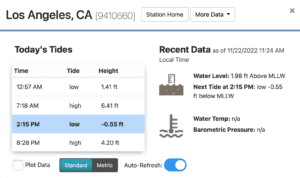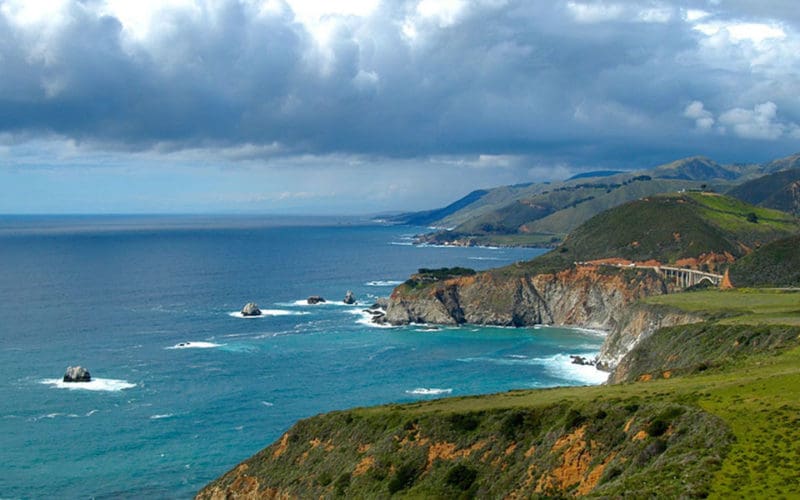 Sadly, I’ve recently realized that, sailing out of Los Angeles, I don’t think as much about the tide as I should. The changing of the tides has little impact on our Wednesday night races, and being tied up to a floating dock in the very sheltered Marina del Rey basin means my boat always feels to be in a safe place. There have been times when I had to be very aware of what the tide was doing, like when sailing along the southern coast of England or crossing Long Island Sound. Growing up in Connecticut, I was taught that there are two high tides and two low tides every day, but as it turns out, this is not absolute, but depends on where you are in the world
Sadly, I’ve recently realized that, sailing out of Los Angeles, I don’t think as much about the tide as I should. The changing of the tides has little impact on our Wednesday night races, and being tied up to a floating dock in the very sheltered Marina del Rey basin means my boat always feels to be in a safe place. There have been times when I had to be very aware of what the tide was doing, like when sailing along the southern coast of England or crossing Long Island Sound. Growing up in Connecticut, I was taught that there are two high tides and two low tides every day, but as it turns out, this is not absolute, but depends on where you are in the world
A semidiurnal tide is a tide cycle with two high and two low tides near the same size on the same day. This type of tide occurs off the Atlantic coast of the US and the western coast of Africa and Europe. A diurnal tide is a tide cycle with one high and one low tide on the same day. This tide occurs in the Gulf of Mexico and off the Alaskan coastline. A mixed tide is a cycle with two high and two low tides on the same day but at different heights. This type of tide occurs along the west coast of the US as well as Mexico and the Caribbean Sea.
High tide is when the sea is at its highest level. Low tide is when the sea is at its lowest level. The vertical motion of the tide, causing the ocean water to move toward the shore, is called the flood. The vertical movement of the water when it moves away from the land or out to sea is called the ebb. Neap tide is the weakest tide and occurs twice a month when the moon is in its quarter phase – when the sun and moon are perpendicular to each other relative to the Earth’s axis. Spring Tide is the largest tide and occurs twice a month during the full or new moon – when the sun and moon are in alignment.
In Alaska, the phenomena known as the bore tide forms a wave on the leading edge of the flooding tide, with a five to 10-foot face, and can be surfed. Red tides and brown tides are not related to the tide, but are instead large algae blooms that can change the color of the water. A rip tide is not a tide but a strong offshore current.
There are records of tidal theory going as far back as the Ancient Greeks. Isaac Newton wrote about tides in his great work Principia, describing a theoretical circumstance in which oceans uniformly cover the planet. A significant flaw with his theory was that it did not consider the continents or varying depths of water. We can thank Pierre-Simon Laplace for solving the riddle in 1775. In Dynamic Theory of Tides, he considers factors such as depth, the width of the oceans, the Earth’s rotation, friction, and rhythmic forces.
Thanks to science, we know that the tide results from the gravitational effect of the moon orbiting the earth and the earth’s orbit of the sun. The gravitational impact of the sun is almost half compared to the moon. The gravitational effect caused by the moon and sun is called tidal force. Gravity is most substantial on the side of the earth facing the moon, pulling the water towards the moon, causing a tidal bulge, high tide. On the opposite side of the earth, gravity is weakest, which results in a second high tide bulge. Low tides are experienced on the sides of the earth that are perpendicular to the moon. The axis of the Earth’s rotation is 23.5 degrees off from the plane of Earth’s orbit around the sun. Also, the moon’s orbit is tilted about five degrees off the plane of Earth’s orbit around the sun, causing a maximum tidal bulge near the Earth’s equator.
The timing of tidal occurrences changes daily because a lunar day is longer than an earth day, 24 hours and 50 minutes for every rotation of the Earth. The moon’s orbit around the Earth is 27.322 earth days, and the irregularity of the continents on the surface of the Earth restricts the water from freely flowing towards the moon’s pull. And, in fact, the topography of the sea bottom is a major factor in local tide characteristics. These factors are why there are differences in tides depending on when and where you are in the world. You can access NOAA tide data for the US at this NOAA site.
Will Sofrin lives in Los Angeles with his wife and six-year-old daughter. He is a graduate of IYRS School of Technology & Trades, where he apprenticed in the wooden boat restoration program. After completing the program, he spent a decade working as a professional sailor, earning his 100-ton master’s license, and using his specialized wood-working skillset to secure positions on yachts and ships sailing through Europe, New England, the Caribbean, Central America, and the California coast. In 2014 he launched a design firm specializing in managing the restoration of historic homes and developing ground-up architectural packages for luxury residential homes. He still sails actively on his Pearson 33-2, participating in races in Santa Monica Bay as well as a number of double-handed near coastal races.

